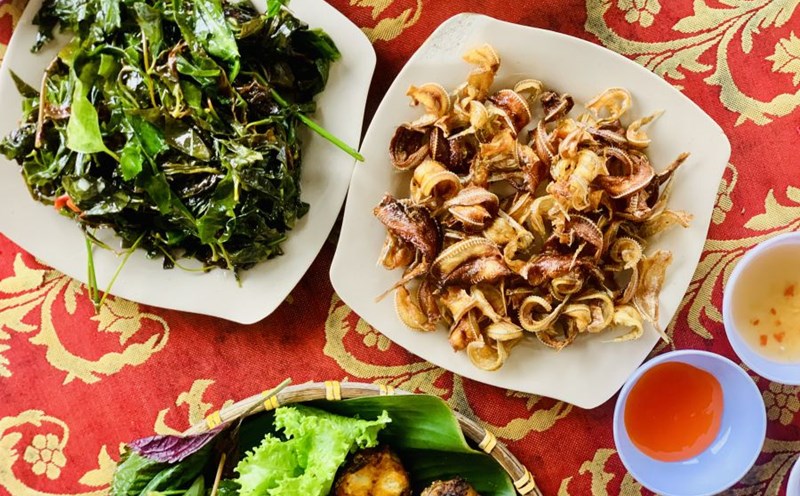IN THE PAST WE ATE RATTAN, NOW WE EAT SHOOTS
The M'nong are the indigenous people of Dak Nong province, accounting for 50% of the total M'nong population in Vietnam (about 50 thousand people). The land where the M'nong live is called the M'nong plateau and is mostly under the administrative territory of Dak Nong province.
On this land is a rich treasure of culture, beliefs, and folklore of the MN'nong people, with a system of ancient stories, myths, and epics - Ot N'rong - that have been passed down orally for thousands of generations, imbued with heroic qualities and the cultural identity of the nation.
In that treasure trove there is also a special culinary area, with dishes that represent the close connection between the M'nong people and their living space, natural conditions, animal and plant ecosystems, and cooking and eating habits and customs. For example, bamboo shoot soup, a dish that makes the M'nong people moved to tears like the Vietnamese water spinach soup or the H'Mong people's mustard green soup...
Therefore, in the first meal welcoming us in Dak Nong, our colleagues at Dak Nong Newspaper could not help but introduce this special soup of the M'nong people, which has now become a sign of local cuisine, even though the name of the soup is as long as a howl in the forest: Canh thut dot may, rau bep, ca dang.
Suddenly I thought about something when I heard the name of the soup being called. My childhood memories were filled with the joy of being beaten with a rattan stick, a kind of whip that was flexible, cut through the wind, and left behind eels that did not disappear for days. In the past, which child was not afraid of rattan sticks, even though they were the soul of the Vietnamese weaving industry?
However, the bamboo shoots are very soft, melting in the mouth like butter. The bamboo shoots are the top part of the rattan tree, which has thorny stems and looks very scary. The M'nong people love rattan very much, not to make whips but to weave baskets - a familiar and very useful tool.
And the rattan tree produces delicious shoots. It is not clear what caused the M’nong people to pick rattan shoots to cook soup, but perhaps it is the product of some “forest eating” experiment. Forests in Vietnam are everywhere, and wherever there are forests, there are rattan shoots, but no region eats rattan shoots like the M’nong.
However, rattan shoots cannot be eaten immediately like vegetable shoots but must be processed. First, the rattan shoots are grilled over hot coals until soft, then torn into thin strips by hand before stir-frying or cooking in soup. The taste of rattan shoots is initially bitter and acrid, then turns sweet, rich, and fatty, creating a very unique flavor.
For those who are sensitive to bitterness, they will probably skip the first piece of bamboo shoot, because it is more bitter than bitter melon. But like bitter melon, when the bitterness is over, there will be a sweet and rich scene because the young part of the bamboo shoot is especially fatty and rich, just grill it, dip it in salt and green chili and you will have a delicious piece.
Bamboo shoots are very versatile in preparing delicious dishes. Simply grilled with salt and chili or salad, more elaborately stir-fried with meat or used as hotpot vegetables, if you want to eat sweet and soft bamboo shoots, cook congee, stew bones, cook thut soup or pound it with dried fish. It is truly soft like bamboo, whatever style you like, you will enjoy it that way.
Then there is the betel leaf. This name sounds very strange, but in fact it entered poetry during the anti-American resistance war, with the song “Light the fire, my dear”. Musician Huy Du certainly also ate a lot of betel leaf soup, also loved its delicious taste, and then sang: “Betel leaf, wild vegetable, adds to the love of my foster brother”.
I don’t know why, but now many people sing it as “La pandan”, which is only for color and flavor, but cannot be eaten. It must be la bep or also called la nhip, a wild vegetable that grows abundantly from Truong Son to the Central Highlands, and added green color to the American resistance meals.
At the beginning of the rainy season, young betel leaves bloom in abundance and that is the most delicious and cleanest stage, when cooked, it will bring a special flavor of the great forest. Betel leaves are long, have a light gloss, young leaves are earthy yellow or slightly pinkish red, older leaves are green, looking a bit like young mango leaves but shorter. When cooked, eating betel leaves has a slightly astringent taste, sweet, nutty and slightly crunchy.
There is still one thing missing to complete the set, which is the bitter eggplant of the Central Highlands, a vegetable that many other places "ignore because it is too bitter". However, the M'nong people love the bitter taste of the eggplant, and then use it to cook soup, braise eel, braise fish, stew buffalo skin, and thinly slice porcupine meat....
CLOUD BOOTH SOUP
Now that the ingredients are ready, let’s cook the soup. The soup sounds strange, right? But it is a part of the culinary culture of the M’nong people, similar to the way of making “lam” in the northern mountainous region. To cook the soup, you must also use bamboo tubes or bamboo tubes to make the “pot”.
Bamboo is also bamboo but bigger than normal bamboo, like luong. Cut fresh pieces, not too young and not too old, about 1 meter long, hollow out the mouth of the tube so that the water inside the tube does not spill out when cooking. Then put rattan shoots, water spinach, bitter eggplant, stream fish or pork into the bamboo tube, close the mouth tightly and "grill" on the stove, turning while grilling until evenly cooked.
Cooking this soup requires very little water because the bamboo tube already has water. This natural bamboo water will give the soup a very distinctive aroma. After the soup is almost soft, put the bamboo tube back up, open the lid and use a bamboo stick to push it up and down.
It is this action that gives the soup its strange name “thut”. Its function is to soften the ingredients in the soup, mix them well to absorb the spices, creating a delicious, thick soup, imbued with the color and flavor of the Central Highlands mountains. Even the stream fish at this point is soft and can be eaten with the bones, so it is very nutritious.
As the M’nong people usually eat, the soup is poured into a large bowl for everyone to eat. But at the restaurant, the soup is poured into a deep plate, because it has become a thick substance, only the pieces of ivory-white bamboo shoots or the dark color of the cooked rau bep can be seen.
Put the first spoonful into your mouth, at first the bitter taste covers everything, if you taste it, it is the bitter taste of bamboo shoots, if it is more bitter, it is the bitter eggplant. But then, after that, there is a rich taste, the more you chew, the more rich and sweet it becomes, along with the pungent taste of betel leaves, a little sour and astringent.
Taking another bite of the spicy chili, the bitterness suddenly disappeared, leaving only a very attractive, soft and pleasant flavor. It turned out that the spiciness of the chili harmonized all the flavors in the soup, as if it was the balance point of the dish.
That is why the dish of bamboo shoot soup that looked very ordinary at dinner created enough of an impression to overshadow the other dishes. And for the first time, the bamboo piece became sweet and soft like that, without making us jump. This bamboo piece is the knowledge of the M’nong people’s “forest eating” for thousands of years on this land.
That knowledge also lies in the unique way of cooking bamboo shoot soup of people living in the forest, living with the forest. Thanks to that, we can understand why the M’nong people are moved by bamboo shoot soup, because it is the thread connecting them with their ancestors of thousands of years ago and the great Central Highlands.











